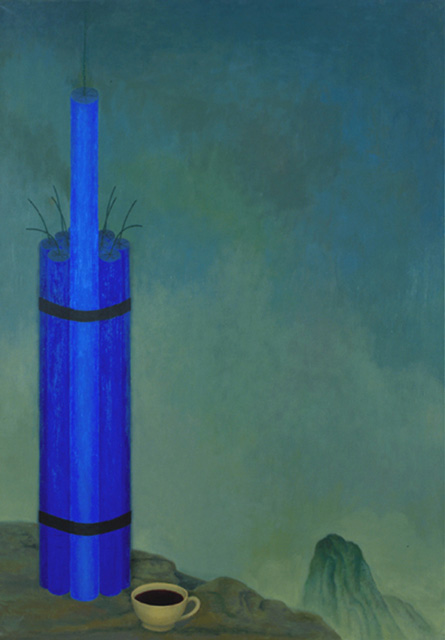


Gregory Pryor's art is propelled by his intense interest in painting. That may seem too obvious a statement, but Pryor's interest in painting has taken him in some startling directions. 'After I left art school', Pryor remarked, 'I didn't do any paintings for three years. ... I went and looked at shows of paintings. I looked at people looking at paintings'.1 Pryor's interest in painting prompted him to ask what interested others about them; his observation eventually led him to develop work that was theatrical, seductive and sensuous.
I noticed that people enjoyed looking at paintings of scenes. If a painting depicted a scene in a world view that was real or imaginary, then people would lean towards the work, rather than step back in their appraisal ... [These paintings] had a power to draw people in to see more, and often, a whole new world unfolded inside these pictures.2
In constructing scenes that would fascinate and intrigue viewers, Pryor turned initially to the associative imagery of Surrealism and to the figurative tradition that has always remained strong in Australia. To this he added the experience of viewing art in the European tradition—especially the work of so-called Italian 'primitives' of the Italian Renaissance—during his travels. Almost from the outset, Pryor discovered a challenging discrepancy between his observations and art itself:
When you walk through PARIS, you receive visual, aural, and sensual STIMULUS of a MULTITUDE of FORMS and INTENSITIES. One doesn't have to seek this, it JUST HAPPENS, rather simply. The mystery is: WHY CAN WE RECEIVE THIS CONFUSING INFORMATION SO EASILY, YET IN TRYING TO DOCUMENT OR DEPICT IT, WE ONLY FIND DIFFICULTY?3
In the face of this mystery, Pryor has continued to produce art works—born of travel, observation and reflection—whose hallmark is an evocative sensuality articulated on delicately painted surfaces. These qualities are evident in Dynamite and a cup of blood (1996) and in the artist's comments upon the series from which it is drawn, Paintings from the bed of a long green river:
On a recent trip to France, I looked deep into the murky green waters of the Seine and from inside the swirling currents, I could see many stories. There are stories about Alfred Nobel and the invention of dynamite. There are stories about the purity of bamboo and the stillness of Chinese landscape painting. There is the story of Marco Polo and the spires of Gothic cathedrals. Through all these stories we hear a dialogue between nature and culture, between East and West, and between the active and contemplative states of the human condition.4
Here the artist signals a shift in attention from Europe to Asia, a change in focus that became increasingly important in Australian art as a whole during the 1990s. Pryor's earlier paintings echoed the strange puppet theatre landscapes of the Italian Trecento, allowing him to steer a path away from the media-conscious, Pop Art strategies of the 1980s. In turning to the Asian landscape tradition in the 1990s, he engaged with a tradition that encouraged him to amplify his interest in the mysterious poetics of 'scenes'.
Cultural exchange also figured in the series. The needle-like spires of Gothic cathedrals were relocated to the misty peaks of Chinese mountain ranges, and motorcyclists' helmets were scattered among the round boulders of a river bed. In Dynamite and a cup of blood, Alfred Nobel's destructive invention returns to China, where gunpowder was first produced. As Pryor suggests, trade, science and culture have rebounded back and forward between East and West for centuries.
Double gourd (1997), Heavy gourd (1997) and Landscape with two suitcases (1997) were all produced during a residency at the Beijing Academy of Art. Travelling in Shanxi and Shaanxi provinces with artist Feng Yong, Pryor responded directly to the landscape. After Pryor had painted on scrolls, he passed them on to Feng Yong for his 'response'. As Feng Yong reported, Pryor was happy for cultural exchange to take place on a human level, nor was he afraid to make a scene of himself. 'He begins drawing the mountain, but he is soon surrounded by curious children ... He gives each of them a metal kangaroo badge and then he starts bounding around like one, shrieking "Australia!", "Australia!"'.5
- Chris McAuliffe
Gregory Pryor is represented in Australia by Turner Galleries, Perth.